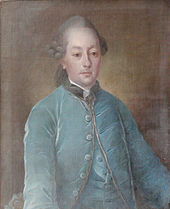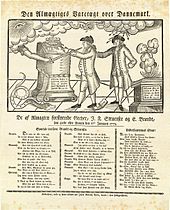Enevold von Brandt
Enevold von Brandt (born September 7, 1738 in Copenhagen , † April 28, 1772 ibid) was a Danish count and courtier who was executed together with Johann Friedrich Struensee .
Life
Brandt was the son of the cabinet secretary and city councilor Carl Brandt zu Teichhof (1696–1738) and Else Berregaard (1715–1793). He had an older brother Christian. Both were court squires from their youth. Brandt attended the Sorö Knight Academy , studied law and became an assessor at the Supreme Court in 1764. His brother made a career as an administrative officer and was administrator of the County of Rantzau since 1764 . It was there that Brandt met the land physicist Struensee.
Brandt had been appointed chamberlain as early as 1760 and apparently preferred court service to legal profession. In the hope of a career at the court with the young King Christian VII, he denounced the royal favorite Conrad Holck in a letter dated May 2, 1768 and offered himself as his replacement. The desired success did not materialize: Brandt was banned from Denmark with immediate effect , but kept his salary. He traveled to Paris , where he made the acquaintance of Voltaire . When Christian VII came to Paris on his European tour in July 1769, Brandt asked him and the actual regent Johann Hartwig Ernst von Bernstorff for a pardon. Although he was not allowed to return to Denmark, he was appointed chamberlain and received a position in the county of Oldenburg , which was linked in personal union with Denmark and was administered by Bernstorff as director of the German chancellery .
In 1770 Struensee called him back to the court. He had now realized that the king was easy to steer when exposed to the appropriate influences. Struensee had already taken care of Bernstorff's removal. Now Brandt was supposed to entertain the king and thus push back the influence of his drinking companion Conrad Holck. Under Struensee's protection, Brandt received numerous offices and titles, as well as a good income. On January 29, 1771 he was awarded the Order of Mathilde , donated by Queen Caroline Mathilde . But contrary to what the lawyer had expected, Struensee did not involve him in his reforms. Although he had been appointed director of the royal theater, the picture gallery and the art chamber, Struensee's austerity measures left him no scope for his own plans. Instead, Struensee only asked him to keep the mentally ill King, who was increasingly suffering from fits of rage, happy. In September 1771, Brandt asked Struensee by letter to be released and at the same time complained about his despotic behavior, but Struensee convinced him to stay. To reassure the king, he called back his former teacher, Élie-Salomon-François Reverdil . On September 30, 1771, Brandt and Struensee were raised to the rank of liege count ( lensgreve ), but without the lands that actually belonged to them. With Struensee's opponents and the people, Brandt was therefore considered a co-conspirator. Since the king enjoyed fights, Brandt could not avoid it. In November 1771 the incident occurred that later cost Brandt his life. Christian VII did not take the scratches offense, however, but appointed him a few days later, on November 26th, Grand-Maître de la garderobe du Roi .
On January 17, 1772, Brandt was arrested together with Struensee and imprisoned in the Copenhagen castle . On April 25, he was sentenced to death for treason and lese majesty . During his detention he showed no signs of alarm. Instead of confessing his sins to Pastor Hee, who was assigned to him, he occupied himself with music. That is why he is depicted playing the flute on leaflets that mocked the arrested. On April 28th, Brandt was led onto the scaffold in front of Struensee. Even on the way there, he was still counting on his pardon, as he came from an influential family. Besides, the only crime he was charged with had been a playful fight with the king that left Christian VII with a harmless scratch. His coat of arms was smashed. Before he was beheaded , his right hand was cut off. His body was quartered and braided onto the wheel. His brother is said to have collected the remains and buried them anonymously in a coffin in St. Peter's Church in Copenhagen.
literature
- Enevold Brandt in Dansk Biografisk Leksikon
- Matthias Blazek: The execution of Count Enevold Brandt and Johann Friedrich Struensee in 1772 - Driven to the high court in two open wagons, covered by 400 dragoons . Sachsenspiegel 25. In: Cellesche Zeitung , June 25, 2011
Web links
Individual evidence
- ^ Bomann Museum Celle (ed.): Struensee. The case. Defamation and overthrow of a reformer . Hanover 2011; P. 63
- ^ Stefan Winkle : Johann Friedrich Struensee. Doctor, enlightener and statesman. Contribution to the cultural, medical and epidemic history of the Enlightenment period. 2nd, revised edition. G. Fischer, Stuttgart 1989, ISBN 3-437-11262-7 ; P. 241.
- ↑ Johannes Jensen: Johann Friedrich Struensee (1737-1772) on the homepage of the German-speaking St. Petri Congregation in Copenhagen
| personal data | |
|---|---|
| SURNAME | Brandt, Enevold von |
| ALTERNATIVE NAMES | Brandt, Enevolt von |
| BRIEF DESCRIPTION | Danish count and courtier |
| DATE OF BIRTH | September 7, 1738 |
| PLACE OF BIRTH | Copenhagen |
| DATE OF DEATH | April 28, 1772 |
| Place of death | Copenhagen |

